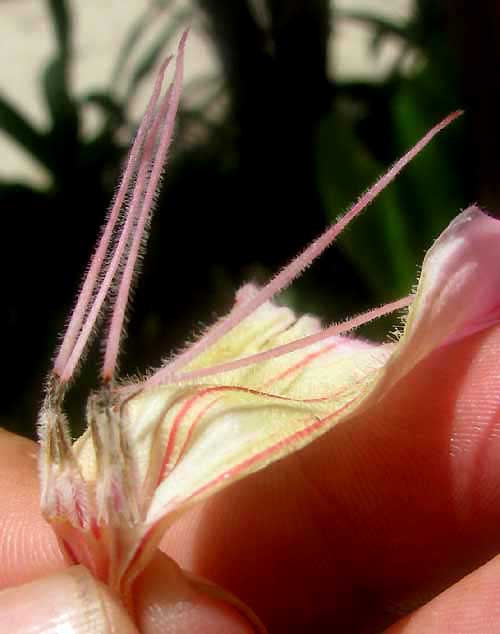Excerpts from Jim Conrad's
Naturalist Newsletter

from the August 21, 2011 Newsletter issued from Mayan Beach Garden Inn 20 kms north of Mahahual; Caribbean coastal beach and mangroves, ~N18.89°, ~W87.64°, Quintana Roo state, MÉXICO
ADENIUM
Marcia definitely has gathered some interesting plants at Mayan Beach Garden. When I arrived a potted one caught my eye because its gray, succulent stem bulging into at the base looked like a stem of the Mexican Poneytail (genus Beaucarnea) often seen in the Yucatan, but its leaves were completely different. I've been awaiting that plant's flowers so I could identify it, and now this has happened. That's it above.
A glance at the flowers told me what family the plant belonged to, for the large, trumpet-shaped corollas with their five flaring lobes are very similar structurally to Yellow Oleander, Oleander, Frangipani, Mandevilla, Mangrove Vine and others we've seen lately -- all members of the Dogbane Family, the Apocynaceae. Remembering that those flowers all have five anthers clustered at their mouths, I opened a flower plucked from our potted mystery plant and saw what's shown below:

In the picture's lower, left corner, the slender, fuzzy, brownish items directed upward are anthers clustered at the flower's mouth. However, there's also this: Each anther is topped with a stiff, pink-toothpick-like appendage. Those appendages help define the genus of our mystery Dogbane-Family plant. What we have here is one of the many horticultural cultivars of ADENIUM OBESUM, the "obesum" referring to the fat, bottom-bulging, succulent stem.
Well, this is excellent. Adenium is known as a genus of spectacular succulents from tropical Africa and Arabia, some of them making small trees with swollen trunks and standing up to 15 feet tall. And, as one website declares, "Despite their beauty and ease of culture, adeniums are not nearly as popular as one might expect. Perhaps they simply haven't received the exposure they deserve."
Among the neat facts about Adenium obesum is that it, along with a couple other species, contains toxic cardiac glycosides, used as arrow poison throughout Africa for hunting large game. The species is also much used in bonsai.
In the English-speaking world the main common name for Adenium obesum is Desert Rose, which is disgraceful. You can see that the plant is nothing like a rose, plus there's much more to it than that it grows in the desert. Such wonderful species deserve better. In fact, many nurseries now just call it Adenium.
You can get a good orientation on the genus Adenium at http://adenium.tucsoncactus.org/.